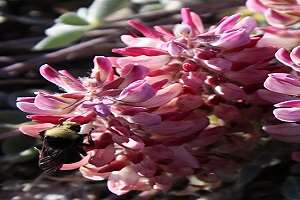Lassics Lupine Threatened With Imminent Extinction Due to Climate Change

Photo by David Imper. Photos are available for media use.
Lassics Lupine Threatened With Imminent Extinction Due to Climate Change
In response to a petition from the Center for Biological Diversity and allies, the U.S. Fish and Wildlife Service announced today that the Lassics lupine, an imperiled pink alpine wildflower, may warrant protection under the Endangered Species Act. In January the Center, joined by two scientists and the California Native Plant Society, sought emergency protection for the flower, which is at risk of disappearing due to climate change.
There are only two known populations of the lupine, both growing above 5,000 feet in elevation on the talus slopes of Mount Lassic and Red Lassic Mountain in Humboldt and Trinity counties. The flower’s total global range is less than four acres, and the total current population is estimated to be as few as 60 reproductive individuals, with recent surveys showing it is on the brink of extinction.
“We are at great risk of losing the Lassics lupine to extinction so protection and recovery actions can’t some soon enough if we are to save this beautiful flower,” said David Imper, former plant ecologist for the Arcata office of the Fish and Wildlife Service and leading researcher of the flower. “We urge the Service to grant emergency protective measures for this wildflower.”
The Lassics lupine is threatened by climate change, altered fire regimes and increased predation by mammals due to climatic and vegetative changes in recent years. Over the past 15 years, the lupine’s range has been shrinking due to increasingly harsh conditions caused by decreasing rainfall, decreased snowpack and increasing temperatures. As conditions have become hotter and drier, predation on the flower’s seeds has increased. Small mammals have been documented eating nearly 90 percent of the lupine’s seeds.
“The plight of this gorgeous mountain wildflower highlights the need to take urgent action to protect ourselves, and the other species we share the planet with, from climate change,” said Tierra Curry, a senior scientist at the Center. “Climate change isn’t a vague, future threat. It’s driving species to extinction right now, so we have to do something about it right now.”
Surveys estimate the Lassics lupine’s population fluctuated between 500 and 1,000 plants from 2005 to 2014, but the number dropped dramatically last spring following two of the driest and warmest years on record. The Lassic fire burned the area in July and August 2015, and subsequent surveys estimated that 60 or fewer individuals survived.
New plants germinating in 2016 offer some hope in the near future, if mild weather conditions continue.
Click here to see more...